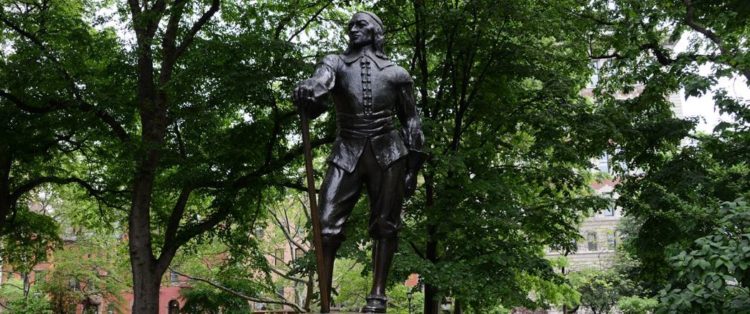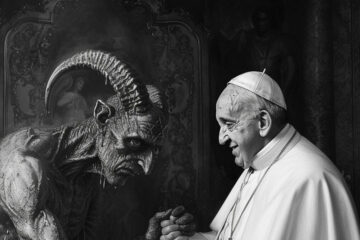Peter Stuyvesant, New Amsterdam, and the Jews
by Karl Radl
JEWS, emboldened by the success of the Black Lives Matter movement in having Confederate monuments torn down, are demanding the removal of statues of historical figures they deem ‘anti-Semitic’ or ‘anti-Jewish’. Atop their list is the statue of Peter Stuyvesant in New York. Stuyvesant was the last Dutch governor-general of New Amsterdam before the territory was surrendered to the English in 1664 and renamed New York. (1)
The demand for the removal of the statue of Stuyvesant is being spearheaded by Nitsana Darshan-Leitner, president and founder of the Shurat HaDin, a Tel Aviv-based lawfare non-profit. (2) Darshan-Leinter’s demands for the removal of the statute of Stuyvesant are predicated upon actions taken by Stuyvesant between 1654 and 1661. These actions are detailed in the Jewish Virtual Library’s entry on Stuyvesant (3) though, interestingly, no mention is made of them in the biography of Stuyvesant published by the University of Groningen. (4).

Stripped from the context in which they were made, Stuyvesant’s actions might arguably be called “anti-Semitic” in the way that term is understood by those not familiar with the Jewish Question. It is the purpose, then, of this article to place Stuyvesant’s actions in their proper context and, in doing so, to show that those actions were not “anti-Semitic” but were consistent with the law of the land and in the best interests of the people of New Amsterdam. What follows is a point-by-point refutation of the main charges leveled against Stuyvesant by the author of the article in the Jewish Virtual Library.
The article in the Jewish Virtual Library opens with the following accusation:
Even the generally tolerant Dutch tried to exclude all but members of the Dutch Reformed Church from their American colonies. (5)
This claim is disingenuous because it implies that the decision to exclude those who were not members of the Dutch Reformed Church was a capricious one made by Stuyvesant due to his prejudice. In fact, Stuyvesant’s efforts to exclude or to otherwise penalize non-members of the Dutch Reformed Church were nothing more than attempts to enforce the edicts that were handed down at the 1618 Synod of Dort. At this Synod, Judaism was recognized as an official religion (6), though limited civil and economic disabilities were imposed upon its followers. These same disabilities were imposed on Catholics, non-denominational Protestants, Lutherans and Muslims. (7). The article in the Jewish Virtual Library makes no reference to any instance in which Stuyvesant failed to apply the Synod’s edicts to members of other faiths.
The article continues with an anecdote concerning 23 Jews who arrived in New Amsterdam in 1654, having fled from Recife, Brazil:
In 1654, 23 refugee men, women and children fleeing from the former Dutch colony of Recife, Brazil, landed in New Amsterdam. These Brazilian Jews were the descendants of perhaps 5,000 Jews who had been living in Recife, most of them secretly, since the mid-1500s. The Dutch captured portions of Brazil from the Portuguese in 1624, and some neo-Christians openly returned to the practice of their Jewish faith. When Portugal recaptured Brazil in 1654, these Jews feared the introduction of the Inquisition and fled. They were probably on their way back to Amsterdam after a stop in Jamaica when their ship was attacked by a Spanish privateer who stripped them of their valuables. A return to Europe was now out of the question. The refugees then made a deal with the ship’s captain, Jacques de la Mothe, to take them to New Amsterdam, which they thought would be a hospitable destination.
This was a one-sided bargain, struck in distress, and when the ship landed in New Amsterdam, De la Mothe filed suit against his passengers for failure to pay the balance of their passage. Peter Stuyvesant (1592-1672), the Dutch colonial governor with an anti-Semitic reputation, seized the Jews’ meager possessions and ordered them sold at auction. When this failed to raise enough to meet their debts, he jailed two members of the group and wrote to the Dutch West India Company in Amsterdam, asking permission to expel the Jews. Stuyvesant noted that the Jews’ indigence might make them a burden on the community and told the company that he “deemed it useful to require them in a friendly way to depart.” (8)
In deciding whether this incident provides any evidence of Stuyvesant’s alleged anti-Semitism, the reader would do well to consider the basic facts, shorn of the emotive language used by the article’s author. Fearful that the Inquisition would be reintroduced by the Portuguese, the 23 Jews attempted to flee to Amsterdam. After the ship they were travelling on was looted, they struck a deal with the ship’s captain to be taken to New Amsterdam, where they believed they would be safe. When he was not paid by the Jews, the captain resorted to the law for recompense. Finding that the Jews were indigent and therefore likely to become a burden to New Amsterdam, Stuyvesant sought permission from his superiors to expel them.
That the 23 Jews themselves sought Dutch protection from the Inquisition, first in Amsterdam and then in New Amsterdam, strongly suggests that the Dutch in general and Stuyvesant in particular were not believed by Jews themselves to be anti-Semitic. Even the author of the article found himself compelled to note that Stuyvesant, in his request for permission to expel the Jews, described the nature of their leaving as “friendly,” which provides no proof of anti-Semitism. Accordingly, the more plausible conclusion is that the charges of anti-Semitism against Stuyvesant were baseless and concocted as retribution for his refusal to carve out an exception to the law to accommodate this group of Jews.
Jewish demands that the law of the Dutch Republic be ignored or changed to suit them, though signally left unmentioned in the article, were not a new phenomenon even in 1654. One notable case was heard between 1621 and 1623. In that case, the Jews of the Dutch Republic and its colonies demanded the right to ship their cargoes of sugar from Brazil in ships owned by enemies of the Dutch Republic, namely England and Spain, and not have them subject to immediate seizure should such ships become prizes of the Dutch fleet or privateers in the ongoing naval war. (9)
After the case was decided against the Jews, it came to light that the Jews were so confident of winning the case that they were shipping their sugar in enemy ships even while the case was being heard, as shown by the fact that the Jewish share of the Dutch sugar trade from Brazil fell to one percent after the case was decided against the Jews. Prior to this decision, Jews held the largest share of any group in the sugar trade. (10) The Jews may have found reason for such confidence in the fact that they were successfully sponsoring and arranging the smuggling of a range of illegal goods to and from the Dutch Republic at the time of the trial. (11)
When considered in context, the picture that emerges is not one of innocent victims being delivered by ill fortune into the clutches of a capricious and tyrannical oppressor. Rather, the Jews who fled to New Amsterdam in 1654 knowingly sought protection from the Dutch Republic based on the favorable treatment they were shown in Brazil, instead of requesting transport to French, English, or Swedish possessions in North America. Only when the laws of the Dutch Republic did not produce the result hoped for by the Jews did they begin to portray themselves as victims of both de la Mothe and Stuyvesant.
The article then introduces the plea the Portuguese Jews in New Amsterdam made to the Jews in Holland:
In a letter now in the archives of the American Jewish Historical Society, the Jews of New Amsterdam wrote to their fellow Jews in Holland asking for help. (12)
Once again, by failing to provide his reader with the context in which the events occurred, the author is able to portray the Jews of New Amsterdam as well as the Jews of the Dutch Republic as victims. Far from being an oppressed and powerless minority, Jews dominated Dutch trade, accounting for some nine per cent of all accounts at the Amsterdam Exchange Bank despite being a tiny minority of the population. (13) Jewish influence on Amsterdam’s stock exchange was so significant that it closed on the Jewish, rather than the Christian, Sabbath. (14) By the time the Jews in New Amsterdam made their plea for help to the Jews in Amsterdam, Jewish domination of the diamond trade in Amsterdam had begun. (15)
The article continues :
The [Jews in Holland] petitioned the [Dutch West India Company] on behalf of the New Amsterdam Jews, noting that Jews were allowed to reside in Holland and even to invest in the company. In April 1655, the company granted Jews permission to emigrate to and live in [New Amsterdam] , “so long as they do not become a burden to the company or the community.” (16)
Conspicuous by its absence is any reference to the financial influence wielded by the Jews in Amsterdam. This, of course, was necessary to support the victimhood theme that is employed throughout the article. The omission, then, clearly is an attempt by the author to convince his readers that the Dutch West India Company changed its policies to allow the Portuguese Jews to remain in New Amsterdam in order to right a miscarriage of justice, not to quiet the angry voices emanating from a financially powerful interest group.
One further point merits closer consideration. The reprieve granted by the Dutch West India Company contained the specific proviso that the Portuguese Jews could continue to reside in New Amsterdam so long as they did not become a burden to the company or the community. The plea made to the Dutch West India Company largely was predicated upon the poverty of the Portuguese Jews. If the Portuguese Jews were poverty-stricken, they had no right to remain in New Amsterdam, per the terms of the reprieve granted by the Dutch West India Company. If they were not poverty-stricken, the premise of the plea made on their behalf to the Dutch West India Company had been created out of whole cloth.
The article continues with an additional instance of Stuyvesant’s alleged anti-Semitism:
Stuyvesant then tried another tack to discourage Jewish settlement.
Stuyvesant importuned the colonial council to bar Jews from serving in the volunteer home guards. The council levied a special tax on Jews to pay for others to serve in their place. On November 5, 1655, Asser Levy and Joseph Barsimon filed petitions with the colonial court asking that they either be allowed to stand watch with the other citizens or relieved of the tax. After an initial rejection and a two-year fight, Levy won the right to stand watch. Levy, who had been one of the 23 refugees from Recife, would emerge as the champion of Jewish rights in New Amsterdam. (16)
As is the author’s hope, Stuyvesant’s actions likely will appear anti-Semitic to a reader unaware that Jews provided most of the espionage agents employed by England, Spain, Portugal and other enemies of the Dutch Republic. (17) Had the reader been provided this information, he would have rejected this further attempt to portray the Jews in New Amsterdam as victims. It would be as insane as employing Al Qaeda operatives to guard a town against Islamic State militants.
Once the Jewish role in espionage is understood, Stuyvesant’s request that a tax be levied on the Jews in New Amsterdam in consideration of the fact that they would not be serving in the home guard can be correctly seen as a diplomatic compromise, not the punitive measure it is portrayed as.
Further, in light of the role the Jews played in espionage, the keen-eyed reader may begin to question Asser Levy and Joseph Barsimon’s motives for engaging in a protracted legal battle to secure the right to serve in the home guard rather than simply paying the tax.
The article makes no mention of Levy and Barsimon’s motives and continues:
When, in December 1655, Dutch troops captured the Swedish territory along the Delaware River, Stuyvesant refused to issue trade permits to Jewish settlers in the new territory. Levy and others wrote to their associates in Holland protesting this discrimination, and the company disciplined Stuyvesant for his actions. The company specified that, from then on, Jews in the colony were allowed to trade and own real estate, but not hold public office, open a retail shop, or establish a synagogue. In 1656, Levy was granted one of the first trading permits. In 1657, he was denied the right to practice a trade but petitioned this injustice and won. When he received his butcher’s license in 1661, it explicitly exempted him from having to slaughter pigs. (18)
Again, if the incident is looked at in a vacuum, Stuyvesant appears deserving of censure for his refusal to issue the trade permits. Stuyvesant’s actions were not taken in a vacuum, though. A more likely reason for Stuyvesant’s refusal to issue the trade permits was a concern that the Jewish settlers would work on behalf of the Swedes to retake the newly captured territory, given the well-known role of Jews in espionage.
Stuyvesant was sent to New Amsterdam by the Dutch West India Company to ensure the security of the colony. He refused the entreaties and blandishments made by the Jews seeking trade permits whereas as the Dutch West India Company, which was focused on trade and profits and therefore more easily swayed by Amsterdam’s financially powerful Jewish community, did not. Stuyvesant’s actions, therefore, appear the product not of anti-Semitism but of a zeal to carry out his most important duty: ensuring the safety of the colony.
The degree of influence exerted on the Dutch West India Company by the Jews in Amsterdam is exemplified by the matter of Asser Levy’s application for a butcher’s license. Not only were the Jews in Amsterdam able to have Stuyvesant’s decision to deny Levy a license overturned, but they were able to procure for Levy an exemption from having to slaughter pigs.
It is also important to note that the edicts handed down at the Synod of Dort would have given the Dutch West India Company a basis for refusing the trade permits and Levy’s butcher’s license. That the company did not do so demonstrates the power which Jewish interests in Amsterdam wielded at the time. In short, the financially powerful Jewish interests in New Amsterdam were the moving force behind the increasingly lenient treatment being afforded the Portuguese Jews in New Amsterdam.
The article concludes by letting slip evidence that Stuyvesant’s concerns about the loyalty of the Portuguese Jews were justified:
When the English captured New Amsterdam in 1664 and renamed it New York, Levy swore an oath of allegiance to the British crown. All the rights he had under the Dutch were conferred to him under the new regime. In 1671, Levy was the first Jew to serve on a jury in North America. (19)
Far from being a victim of Stuyvesant’s anti-Semitism, Asser Levy is shown to likely have been in the employ of the English Crown throughout his residence in New Amsterdam. Had Levy’s loyalties truly lain with the Dutch Republic, it is unlikely that he would have promptly sworn allegiance to the English upon the capture of New Amsterdam, or that the Crown would have conferred the rights upon Levy that it did. The likelihood of Levy’s having been an agent of the English is further demonstrated by his long-running campaign to frustrate Stuyvesant’s efforts to uphold the laws of the colony. It is also instructive to consider the likelihood that the motive for Levy’s campaign to be allowed to join the home guard was that being a member would better allow him to assist the English in subverting and ultimately capturing New Amsterdam.
Stuyvesant, then, emerges as the actual victim of the piece, ill-used by the Jews of his day and treated as a pawn in the war of cultural Marxism being waged by the Jews of today.
References
(1) https://www.jta.org/2017/08/22/news-opinion/united-states/should-new-york-city-remove-statues-of-its-anti-semitic-dutch-governor
(2) https://en.wikipedia.org/wiki/Shurat_HaDin
(3) http://www.jewishvirtuallibrary.org/new-amsterdam-s-jewish-crusader
(4) http://www.let.rug.nl/usa/biographies/peter-stuyvesant/
(5) Ibid.
(6) Russell Shorto, 2013, ‘Amsterdam: A History of the World’s Most Liberal City’, 1st Edition, Doubleday: New York, p. 163
(7) Simon Schama, 1977, ‘Patriots and Liberators: Revolution in the Netherlands 1780 – 1813’, 1st Edition, Collins: London, p. 212
(8) http://www.jewishvirtuallibrary.org/new-amsterdam-s-jewish-crusader
(9) Jonathan Israel, 1982, ‘The Dutch Republic and the Hispanic World 1606 – 1661’, 1st Edition, Clarendon Press: Oxford, p. 126
(10) Ibid, pp. 126-127
(11) Ibid, p. 141
(12) http://www.jewishvirtuallibrary.org/new-amsterdam-s-jewish-crusader
(13) Israel, Op. Cit., p. 47
(14) Alberto Guenzi, 2006, ‘European Expansion in the Seventeenth Century’, pp. 73-74 in Antonio Di Vittorio (Ed.), 2006, ‘An Economic History of Europe: From Expansion to Development’, 1st Edition, Routledge: New York
(15) Geoffrey Cottrell, 1972, ‘Amsterdam: The Life of a City’, 1st Edition, Little, Brown & Company: Boston, p. 73
(16) http://www.jewishvirtuallibrary.org/new-amsterdam-s-jewish-crusader
(17) Ibid.
(18) Cf. Dominic Green, 2003, ‘The Double Life of Doctor Lopez: Spies, Shakespeare and the Plot to Poison Elizabeth I’, 1st Edition, Century: London
(19) http://www.jewishvirtuallibrary.org/new-amsterdam-s-jewish-crusader
(20) Ibid.
* * *
Source: The Purity Spiral







In a simple book at a library, I read the 23 Sephardic Jews wanted to attach themselves to the Dutch government at New Amsterdam. Peter Stuyvesant rejected them — stating “Jews are deceitful creatures who cannot be trusted.”
Our ancestors had a lot more savvy about these despicable creatures than our so-called modern leaders. Just looking at the photo of those two ugly Khazars gives me the shudders!!!!
Friedrich Nietzsche once wrote: “The anthropologists among the criminologists tell us that the typical criminal is ugly: monstrum in fronte, monstrum in animo [‘monster in face, monster in soul’].” Although the Jews aren’t “typical criminals” — they’re quite extraordinary ones, in fact — Nietzsche’s remark is extremely applicable to them.
Are the Jews ugly because they interbreed?
Inbreeding might well be a factor in the repulsiveness of the Jews, both physical and psychological. It might sound paradoxical to some people, but the Jews are a hybrid race, and they practice inbreeding to a high degree. The following website makes it clear that there is a heavy “genetic load” of deleterious mutations in the Jewish gene pool:
http://www.jewishgeneticdiseases.org/jewish-genetic-diseases/
Speaking of inbreeding, the issue of incest among the Jews is addressed by the French writer Hervé Ryssen in his books, but it’s been some time since I’ve read any one of them.
I should note that there’s an interesting discussion of why the Jews are so ugly in Josiah Nott’s article, “The Assault on Art and Beauty.”
https://nationalvanguard.org/2010/10/the-assault-on-art-and-beauty/
The website omits this aspect: jews don’t really excel at anything but a narrow range of professions and skill-sets, such as litigation (based in talmudic conflation and hair-splitting rather than reasoned interpretation of the Constitution), finance (speculation), fashion (gender melding), degenerate art (pre-internet porn), grey-market mercantile (take-it-or-leave-it bargaining), public education, media, medical, and some hard science contributions. Missing from jews is the mental and/or physical grit needed to do traditional farming, technical arts (from classical sculpture to Pixar), carpentry, motor vehicle customization (besides the guy who hot-rodded the hearse on The Munsters) and other blue-collar jobs – construction, pipe-fitting, power line maintenance, for example, and military combat service. Our illustrious Treasury secretary just received a hunk of horseshit delivered from a critic, so I suppose not all jews are happy… Read more »
As a parasitic minority, the Jews occupy a particular ecological niche, and they don’t need to perform the full range of functions required by a complex civilization or culture in order to survive. Their high verbal IQ and their racial solidarity enables them to secure and maintain particular ecological niches quite effectively. Among White nationalists, the issue of Jewish intelligence is a controversial one, and is more complex than is generally appreciated. Several things muddy the water: People are loath to recognize their enemies as intelligent, for intelligence is often seen as a good thing in a moral sense. Intelligence is often conflated with qualities such as creativity and rationality — qualities that might be associated with intelligence but are by no means identical with it. (On these matters, one… Read more »
Superb response. “Intelligence is often conflated with qualities such as creativity and rationality ” is something everyone has to keep in mind. Also, the lack of intelligence has been conflated with destructiveness. The 70 IQ sub-Saharan African living as his ancestors did is far less of a threat to White society, than a 105 IQ Jew who’s become wealthy in the West, and seeks to overturn its traditional society with liberal fads.
Jews are not part of any nation but their own, so can switch civil allegiance as easily as filling out a form.
Jews are straight out of the racial cauldron of the Middle East. Asiatic at root. Mongrel Mongoloids. Like all ethnics in America, they are a set aside program — free lunch or all you can steal.
Governor Stuyvesant had no ambitions to entertain those people.
“A Tel Aviv based lawfare ” what the hell, send her back to Israel and tell her to mind her own business.
Looks like Stuyvesant surrendered to the Yiddish Empire rather than see New Amsterdam massacred. In this age of pollical correctness, if there were any substance to it, the Dutch would deserve to get Manhattan island — less its invaders — given back to them.
thanks,
Jerry Hoekstra
DRAFT of letter to NYC. Paul ————————————— Public Design Commission of the City of New York Sreoshy Banerjea, Executive Director City Hall, Third Floor 253 Broadway New York, NY 10007 New York City, NY November 30, 2023 Dear Ms. Banerjea; The New York Post of September 18, 2023, reported, “The Cultural Affairs Committee’s upcoming hearing involves legislation that would require the city’s Public Design Commission to publish a plan to remove works of art on Big Apple property “that depict a person who owned enslaved persons or directly benefited economically from slavery, or who participated in systemic crimes against indigenous peoples or other crimes against humanity.” The article also reported that, “Peter Stuyvesant, a Dutch governor, early New York settler and a slaveholder, has a statue in… Read more »